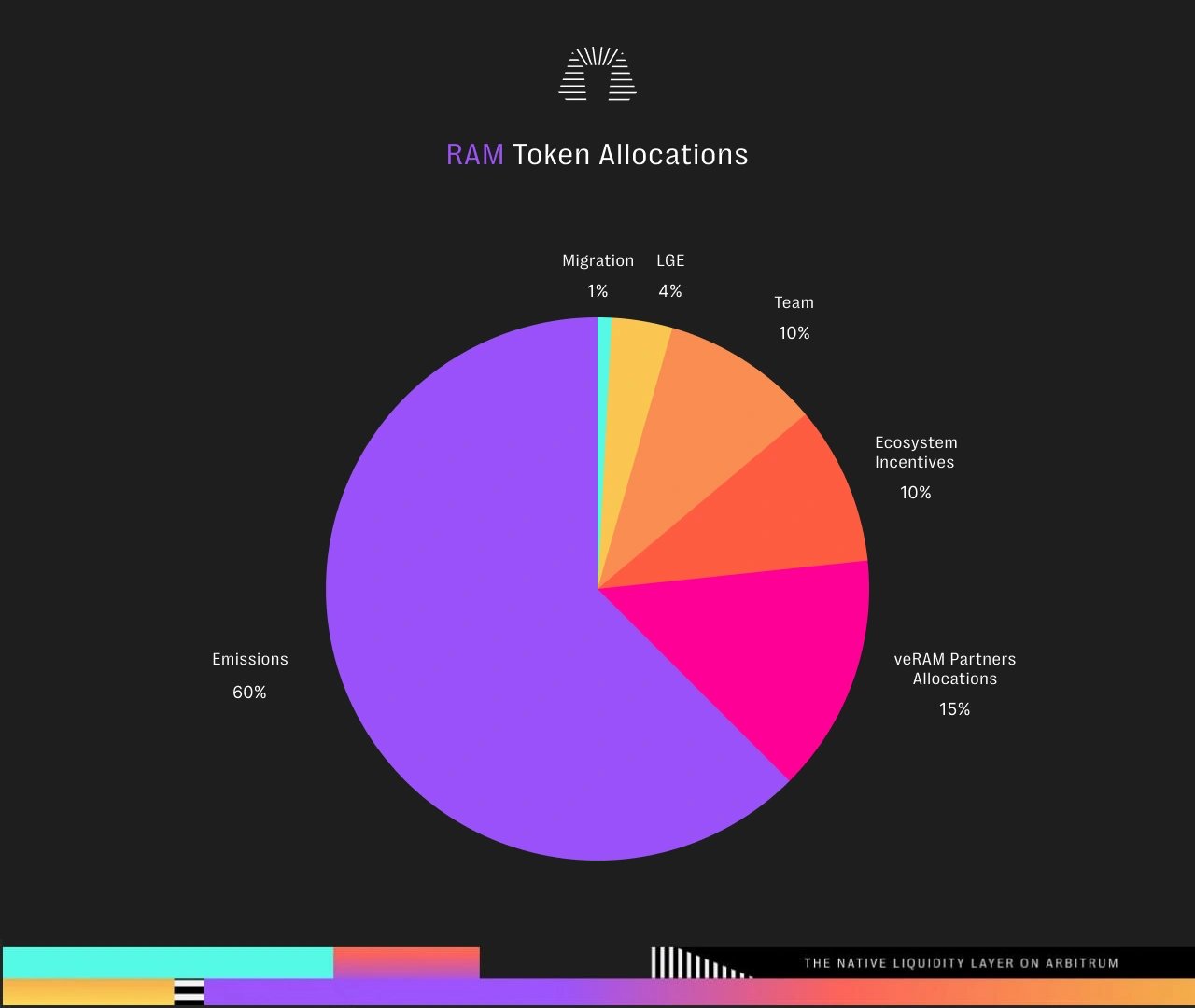订阅 wiki
Share wiki
Bookmark
Ramses
Ramses
Ramses 是一个基于 Arbitrum 的 去中心化交易所,它使用 自动做市商 模型。该协议利用 RAM 代币和 veNFT,并通过允许代币锁定者将协议排放分配给特定的代币对来鼓励流动性。作为回报,锁定者会收到反稀释的 rebase、其选定交易对产生的交易费用的一部分,以及任何针对这些交易对的激励。 [1]
概述
Ramses 使用由 Andre Cronje 设计的 ve(3,3) 模型。该协议根据用户投票决定接收代币排放的池子来分配交易费用,而不是像其他交易所那样将所有协议费用的一部分分配给锁定代币的用户。 [2]
Ramses 通过使用迭代的价格确定函数设计,实现了接近零滑点的效果。Ramses 还结合了一种称为“贿赂”的机制,允许用户或项目将代币排放分配给特定的池子。这有助于为早期阶段的项目提供初始流动性支持。 [3]
该交易所的合作伙伴包括 Liquity、The Ennead、Frax Finance、Liquid Driver、fBOMB、Shrapnel DAO、DEUS、Tarot、YFX、Angle、EI-Ramses、Oath、Inverse Finance、QiDAO、xCAD、GND Protocol、GMD Protocol、Gains Network、Firebird、Jarvis Network、Radiant Capital、DAOMaker、Beefy、Yearn、Granary、Vela Exchange、UNIDEX、Root、Ankr Network、Alchemix、Olympus DAO、Gamma、BLOTR Protocol、Arken Finance、SYMM I / O、Gravita Protocol、Muon、Ethos Reserve、PaintSwap、Swell Network、DefiEdge、Ichi、Davos Protocol、1inch、Paraswap、Odos、Kyberswap、LayerZero、Axelar、Savvy 等。 [4]
功能
交易
滑点和交易价格是根据流动性对中锁定的总价值以及套利活动是否已将池子均衡到其市场价格来计算的。Ramses 引入了两种具有不同交易曲线的流动性池: [5]
- 波动性(UniV2 风格): 这种类型的池子对代币对采用相等的美元价值权重。波动性交易曲线用于在这些池子中执行交易。 [5]
- 相关性(Andre 风格): RAMSES 采用一种稳定的交易曲线,与其他 DEX 相比,该曲线以其效率而闻名。该曲线旨在最大限度地减少滑点,并反映了他对稳定交易的创新方法。 [5]
投票
veRAM NFT 通过投票过程将排放分配给 LP 代币对。排放是根据给定 epoch 中投票的比例来分配的。 [6]
贿赂
Ramses 中提供两种类型的贿赂: [7]
- 投票贿赂: 用户和协议可以向投票者提供奖励。这鼓励投票者选择特定的代币对进行排放。作为投票的回报,提供奖励的用户可以获得奖励的一部分。 [7]
- Gauge 贿赂: 除了排放之外,还可以将代币作为贿赂直接提供给 LP(流动性提供者)质押者。这鼓励了特定代币对中流动性的扩张,特别有利于旨在在 RAMSES AMM 中有效启动流动性的协议。 [7]
归属(veNFT 管理)
为了管理他们的 veRAM,用户可以创建锁并管理它们,方法是增加锁定金额、增加锁定长度和合并 veRAM 位置。 [8]
LP 质押
在 RAMSES 模型中,LP 提供者不会收到交易费用,因为所有费用都将定向到 veRAM 持有者。相反,质押 gauge 用于鼓励用户提供 LP 代币,从而使他们能够获得具有竞争力的 APR。分配给交易对的投票越多,在随后的 epoch 中分配给 gauge 的 RAM 数量就越多。用户的 gauge 提升会影响每个 LP 位置的奖励率。 [9]
Ramses V2
Ramses V2 基于 ve(3,3) DEX 模型,它将 Uniswap V3 的集中流动性设计与原始的 solid 模型相结合。
集中流动性
Ramses CL 在自定义实现中将贿赂与集中流动性相结合,其中平台的大部分收入都定向到 veRAM 投票者。 [10]
与在更广泛的价格范围内提供流动性的流动性提供者相比,在集中范围内提供流动性的流动性提供者可以获得更大份额的排放或奖励。这种模式鼓励与最高浓度的已用流动性相一致的具有竞争力的流动性提供和做市。veRAM gauge 提升机制通过奖励用户积极为 Ramses 系统贡献流动性来补充这一点,从而提高了 veRAM 的效用。 [10]
veRAM 投票者还有其他机会,例如领取投票贿赂和交易费用。CL gauge 中的交易费用在投票者、NFP 和生态系统激励之间分配。所有贿赂奖励都分配给投票者。 [10]
费用层级
RAMSES V2 引入了一系列费用层级,供用户在建立集中流动性头寸时考虑。这些层级旨在满足各种类型的资产对。选项包括: [11]
- 0.01%:此层级非常适合高度相关和挂钩的资产,如 USDC 和 USDT,提供有利的利率。
- 0.05%:非常适合具有竞争力的资产类别,如 USDC/WETH,以产生大量交易量而闻名。
- 0.3%:不属于上述类别的交易对的标准。
- 1.0%:专为高度波动的资产量身定制,提供足够的费用产生以抵消相关风险。
此外,RAMSES V2 还提供额外的费用层级选项:
竞争性挖矿
竞争性挖矿是一种根据 LP 提供者提供的流动性的生产力和竞争力来奖励 LP 提供者的方法。在集中流动性模型中,用户可以灵活地选择他们希望为 LP 提供的特定流动性范围。这允许用户从各种 tick 值中进行选择,从而提供高度的自定义。 [12]
RAM 代币
RAM 是 Ramses 的原生代币。当用户在平台上锁定 RAM 时,他们会收到 veRAM,veRAM 可用于投票决定代币排放的分配,从而决定哪些池子会收到流动性。用户头寸可以通过使用 veNFT(投票托管的非同质化代币)来管理。 [13][10]
代币分配
RAM 代币的总终端供应量为 500,000,000 个。其中,初始分配包括 125,000,000 个 RAM 代币,其中 75,000,000 个代币被指定为 veRAM。 [13]

在总供应量中,1% 分配给 moSOLID 迁移奖励,4% 分配给 LGE,10% 分配给团队,10% 分配给生态系统激励,15% 分配给合作伙伴 veRAM 分配,60% 分配给排放。 [13]
代币经济学
RAMSES 采用 (3,3) 模型,其中包括一种缓解稀释的机制。最初,veRAM 持有者每周收到 50% 的 rebase,这有助于抵消协议排放计划导致的稀释。随着时间的推移,该百分比在每个后续 epoch(周)中增加 1%,直到达到每个 epoch 75% 的反稀释上限。 [14]
veRAM (veNFT)
veNFT 是专门的 ERC-721 代币,它实现了 vested-vote escrow (ve) 模型,代表用户的底层头寸。它们在 RAMSES 生态系统中提供各种功能,包括投票决定 gauge 排放、赚取投票贿赂和交易费用的池子,以及转移或合并 NFT 头寸的能力。此外,veNFT 还通过 Rebases 提供针对稀释的保护。 [15]
基于 PaintSwap 的 RAMSES Bazaar 是 veRAM 交易和易货活动的市场。 [16]
xoRAM
XoRAM 是 1 个 RAM 单位的不可转让表示,安全地存储在 xoRAM 代币 智能合约 中。它为用户提供不同的 RAM 和 veRAM 转换选项,每种选项都需要特定的惩罚和归属期。 [17]
用户可以通过投票贿赂和特定低影响流动性对中的排放拆分来获得 xoRAM。每个 gauge 可以根据流动性对 DEX 健康的影响获得一部分 RAM/xoRAM。核心交易对将获得大部分或全部流动 RAM 的排放。相反,交易量和费用产生非常低的交易对将获得更高百分比的 xoRAM 排放。 [18]
团队
该团队由两位联合创始人 DOG 和 North、前端开发人员 Mali、智能合约开发人员 Ren、顾问 Lafa 和 Dudesahn、管理员 King 以及社区管理员 Achi 组成。 [19]
发现错误了吗?
